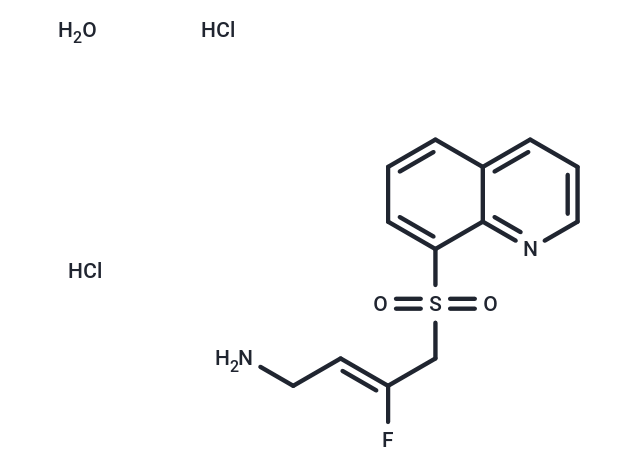Shopping Cart
- Remove All
 Your shopping cart is currently empty
Your shopping cart is currently empty

LOX-IN-3 dihydrochloride monohydrate (Compound 33) is an orally active lysyl oxidase (LOX) inhibitor, intended for research in fibrosis, cancer, and angiogenesis [1].

| Pack Size | Price | Availability | Quantity |
|---|---|---|---|
| 25 mg | $2,140 | 1-2 weeks | |
| 50 mg | $2,785 | 1-2 weeks | |
| 100 mg | $3,520 | 1-2 weeks |
| Description | LOX-IN-3 dihydrochloride monohydrate (Compound 33) is an orally active lysyl oxidase (LOX) inhibitor, intended for research in fibrosis, cancer, and angiogenesis [1]. |
| In vitro | LOX-IN-3 dihydrochloride monohydrate (Compound 33) effectively inhibits bovine LOX and human LOXL2 with IC50 values of <10 μM and <1 μM, respectively, while maintaining prolonged inhibition of LOXL1 and LOXL2 and showing reduced activity against SSAO/VAP-1 and MAO-B [1]. |
| In vivo | LOX-IN-3 dihydrochloride monohydrate (Compound 33) administered at various doses and durations has shown effects on fibrosis and enzyme activity in animal models. A 30 mg/kg oral dose abolished lysyl oxidase activity in male Wistar rats, with plasma concentrations dropping below IC 50 after 8 hours and a recovery half-life of 2-3 days (ear) to 24 hours (aorta) [1]. Daily oral administration of 10 mg/kg for 14 days in a UUO model increased kidney weight and thickness while reducing fibrosis area in mice [1]. A daily oral dose of 15 mg/kg for 21 days significantly decreased lung fibrosis in C57Bl/6 mice, evidenced by reductions in the Ashcroft score and lung weight [1]. |
| Molecular Weight | 371.25 |
| Formula | C13H17Cl2FN2O3S |
| Cas No. | 2414974-55-1 |
| Storage | Powder: -20°C for 3 years | In solvent: -80°C for 1 year | Shipping with blue ice. |

Copyright © 2015-2025 TargetMol Chemicals Inc. All Rights Reserved.